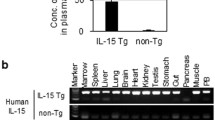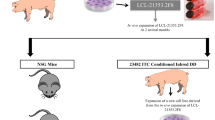Abstract
We successfully established two cell lines, an adenocarcinoma cell line (designated as HIGS) and Epstein-Barr virus-free normal B-lymphocyte cell line (designated as HIGS-BL), derived from a moderately to poorly differentiated adenocarcinoma of the stomach, and examined their characteristics. The tumor delivered to our laboratory from an operating room was cut into small pieces and cultured on the dishes. HIGS and HIGS-BL were established from each individual dish after the onset of primary culture. Although their culture methods were the same, the HIGS cell line was not established from the dishes growing HIGS-BL cells. In addition, HIGS-BL cells were scarcely observed in the HIGS cell dishes. Because of these factors, we have considered until now that HIGS-BL cells may inhibit the growth of HIGS cells or cause damage to HIGS cells by unknown mechanisms. Injection of HIGS-BL cells, other B-lymphocyte cell lines, or the conditioned media of HIGS-BL cells into nude mice bearing HIGS-grafted tumors was performed individually. When HIGS and HIGS-BL cells were co-cultured in the same dishes. HIGS-BL cells inhibited the proliferation of HIGS cells. The inhibition of grafted tumor growth was confirmed by the injection of not only the HIGS-BL cells but also the B-lymphocytes. Furthermore, this inhibition was only observed when the conditioned medium of B-lymphocytes was injected into the nude mice. These results suggested that the secretory products by general B-lymphocytes (including HIGS-BL) have some ability to inhibit the proliferation of HIGS cells. In addition. susceptibility tests to anti-cancer drugs suggested that HIGS cells were sensitive to CDDP, ADM and MMC, and HIGS-BL cells were sensitive to CDDP. If CDDP was used for chemotherapy in the patient, the drug produced atrophy of HIGS-BL cells. The study about HIGS and HIGS-BL cells reported the necessity for novel therapeutic approaches in oncotherapy.
Similar content being viewed by others
References
Takizawa H, Ohtoshi T, Ohta K, et al.: Growth inhibition of human lung cancer cell lines by interleukin 6 in vitro: a possible role in tumor growth via an autocrine mechanism. Cancer Res. 53(18): 4175–81, 1993
Yamaji H, Iizasa T, Koh E, et al.: Correlation between interleukin 6 production and tumor proliferation in non-small cell lung cancer. Cancer Immnol, Immunotherapy 53(9): 786–792, 2004
Miki S, Iwano M, Miki Y, et al.: Interleukin-6 (IL-6) functions as an in vitro autocrine growth factor in renal cell carcinomas. FEBS Lett. 250: 607–610, 1989
Watson JM, Sensintaffar J, Berek JS, et al.: Constitutive production of interleukin 6 by ovarian cancer cell lines and by primary ovarian tumor cultures. Cancer Res. 50(21): 6959–65, 1990
Amano Y, Okumura C, Yoshida M, et al.: Measuring respiration of cultured cell with oxygen electrode as a metabolic indicator for drug screening. Hum. Cell 12(1): 3–10, 1999
Ikuta K, Satoh Y, Hoshikawa Y, et al.: Detection of Epstein-Ban virus in salivas and throat washings in healthy adults and children. Microbes and Infection 2: 115–120, 2000
Kieff E and Rickinson AB: Epstein-Barr virus and its replication. Fields Virology, 4th ed. Knipe DM, Howley PM, et al., eds. pp. 2511–2573, Lippincott-Williams and Wilkins, 2001
Rickinson AB and Kieff E: Epstein-Barr virus. Fields Virology, 4th ed. Knipe DM, Howley PM, et al., eds. pp. 2575–2627, Lippincott-Williams and Wilkins, 2001
Tokunaga M, Land CE, Uemura Y, et al.: Epstein-Barr virus gastric carcinoma. Am. J. Pathol. 143: 1250–1254, 1993
Imai S, Koizumi S, Sugiura M, et al.: Gastric carcinoma: monoclonal epithelial malignant cells expressing Epstein-Barr virus latent infection protein. Proc. Natl. Acad. Sci. USA. 91: 9131–9135, 1994
Author information
Authors and Affiliations
Rights and permissions
About this article
Cite this article
Ohi, S., Hashimoto, H., Tachibana, T. et al. Establishment and characterization of EB virus-free normal B-lymphocyte and interleukin-6-producing poorly differentiated adenocarcinoma cell lines derived from gastric tumor tissue. Hum Cell 18, 35–44 (2005). https://doi.org/10.1111/j.1749-0774.2005.tb00055.x
Received:
Accepted:
Published:
Issue Date:
DOI: https://doi.org/10.1111/j.1749-0774.2005.tb00055.x




